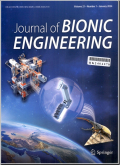Soft Gecko-shaped Tail with Passive Auto-reset Joint Enhances the Locomotion in Gecko-inspired Climbing Robots
摘要Gecko-inspired robots have significant potential applications;however,deviations in the yaw direction during locomotion are inevitable for legged robots that lack external sensing.These deviations cause the robot to stray from its intended path.Therefore,a cost-effective and straightforward solution is essential for reducing this deviation.In nature,the tail is often used to maintain balance and stability.Similarly,it has been used in robots to improve manoeuvrability and stabil-ity.Our aim is to reduce this deviation using a morphological computation approach,specifically by adding a tail.To test this hypothesis,we investigated four different tails(rigid plate,rigid gecko-shaped,soft plate,and soft gecko-shaped)and assessed the deviation of the robot with these tails on different slopes.Additionally,to evaluate the influence of different tail parameters,such as material,shape,and linkage,we investigated the locomotion performance in terms of the robot's climbing speed on slopes,its ability to turn at narrow corners,and the resistance of the tails to external disturbances.A new auto-reset joint was designed to ensure that a disturbed tail could be quickly reset.Our results demonstrate that the yaw deviation of the robot can be reduced by applying a tail.Among the four tails,the soft gecko-shaped tail was the most effective for most tasks.In summary,our findings demonstrate the functional role of the tail in reducing yaw deviation,improving climbing ability and stability and provide a reference for selecting the most suitable tail for gecko-inspired robots.
更多相关知识
- 浏览0
- 被引0
- 下载0


相似文献
- 中文期刊
- 外文期刊
- 学位论文
- 会议论文



 换一批
换一批 换一批
换一批



